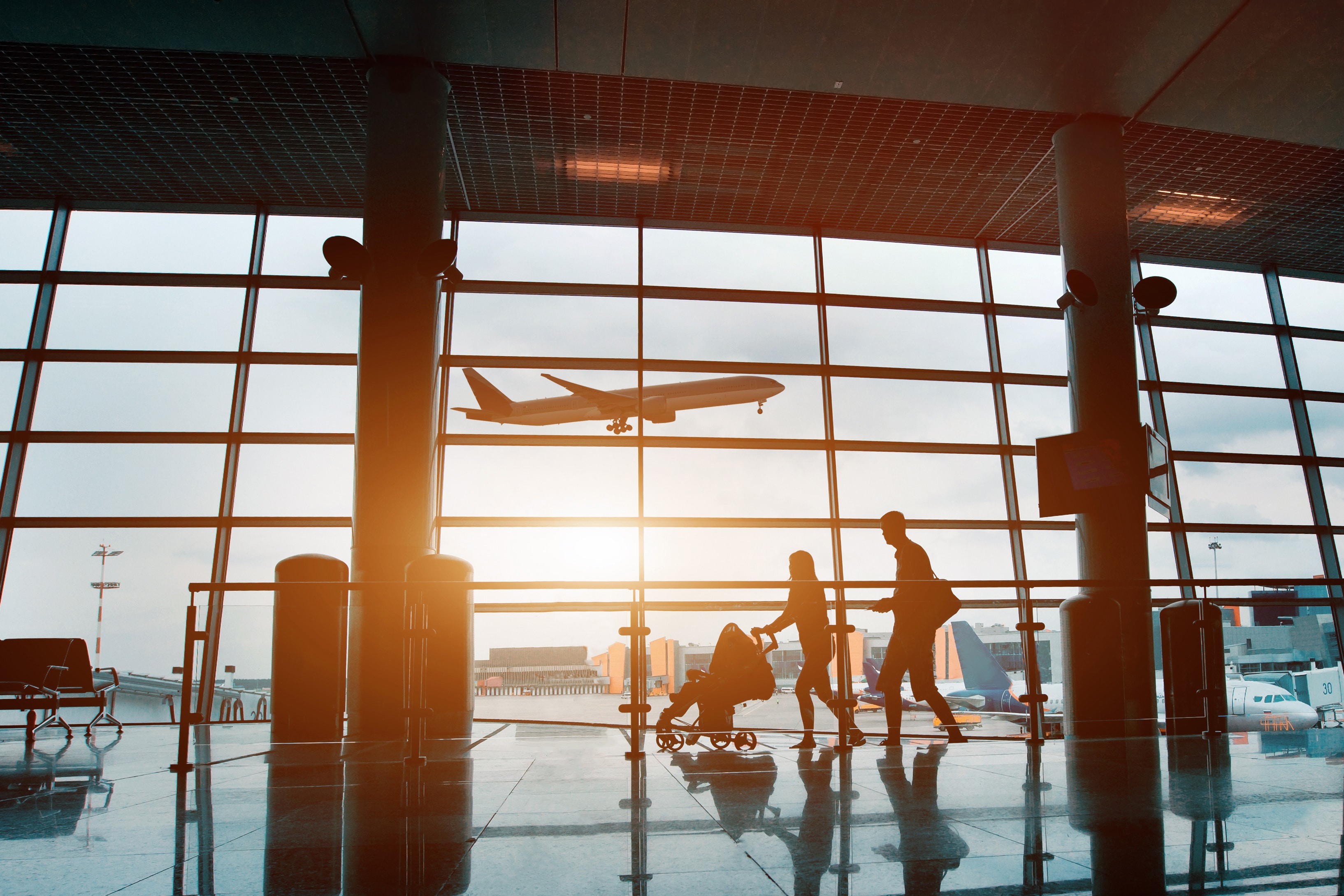Hitting the road this holiday season? Traveling with a family can be stressful, so see our pediatricians’ tips for traveling with kids to stay safe and healthy.

It’s travel season! This is a popular time for many of us to shake off the winter blues, pack up our bags, and visit loved ones or head off to warmer places. We’ve got plenty of tips to help keep these new family memories as healthy as possible for your children, so pack your bags, fasten your seatbelt, and let’s go!
Flying with Small Children? Tips for Air Travel with Infants and Toddlers
Travelling with small children through airports can make you wish that you had 2 extra sets of arms! You’ve got the diaper bag packed to the brim, the luggage, the stroller, the toys, the snacks, and the kids. Why would you want to want to add an “optional” car seat (and the cost of additional airfare) when you can cut the clutter and keep your baby on your lap?
1. Safety
While a child under 2 years may be allowed to ride on an adult lap and not be secured in a child restraint system (CRS, i.e. car seat) during take-off, landing, or turbulence, the evidence is clear that CRS’s protect against injuries and death from survivable crashes and turbulence. While caregivers assume they will be able to hold onto their child in an emergency situation (sudden turbulence, aborted take-off, or survivable crash) G-forces may reach 10-25G, far too strong for a parent to keep a child in their arms. In fact, in a recent study examining in-flight injuries in children 0 to 18 years of age, lap infants comprised over one-third of all in-flight injuries in children, largely due to falls.
Aircraft seatbelts don’t adequately protect children under 3 years of age, and the American Academy of Pediatrics recommends that all children be restrained in an age-appropriate restraint device. You’d never think to let your baby ride on your lap in a car going 50mph, so why would you let them ride on your lap in an aircraft going 500mph?
2. Convenience
Yes, really! Young children are more comfortable in a seat that fits them. They tend to sleep better (and longer) in a secured CRS (and you’ll now be free to stretch or use the lavatory when you need to). You won’t have to hold a squirmy infant for hours on your lap. And you won’t have to worry that the rental car service at the airport has the wrong type of safety seat for your child, or for the car that you’re renting. Still skeptical that it’s worth the hassle to bring another bulky item through the airport? Compact devices like this one turn your child safety seat into a travel stroller and are a convenient way to transport your child (and safety seat) through the airport. Read this for more tips on easier plane travel with kids.
For more resources on using a safety seat with your child when flying, check out the following great articles:
- Why Should Your Child Use a Car Seat on an Airplane?
- Which Car Seats Can Be Used on Airplanes?
- Before You Fly, Know Your Rights!
One last in-flight safety tip: Burns from spilled hot liquids, and lacerations/contusions from refreshment carts are also frequent causes of in-flight injuries to young children. Children (with or without a CRS) are safer in the window seat compared to an aisle seat, where hot drinks are not likely to pass over them, and where moving carts will not crush small fingers. (All CRS’s are already required to be installed in the window seat due to additional exit safety concerns.) So keep your child in the window seat, and let them enjoy the view!
Heading to Sunny Skies?
No one wants a sunburn as a travel souvenir! Protect your child with these sun safety tips. And don’t forget – sun safety is important for winter sport destinations as well, where snow can reflect 80% of the sun’s UV radiation, creating a “double exposure” from above and below. Make sure your child wears protective eyewear with 100% UV protection, in addition to protective clothing and sunscreen. Find more winter sport sun safety tips.
Going Abroad?
Depending on travel location, you and your child may be at risk for certain infections including traveler’s diarrhea, typhoid fever, hepatitis A or B, and mosquito-borne infections such as malaria, zika, or dengue, to name a few! Given that disease outbreaks may occur on a rapidly changing basis, it’s a good idea to check the CDC’s Traveler Health page at least 4-6 weeks before travel for destination-specific, up-to-date travel alerts, so you can plan ahead for any necessary travel vaccine or disease prophylaxis.
As a reminder, your child should at minimum be up to date on all routine vaccines before travel, including the seasonal influenza vaccine during influenza season – especially important as you go through busy airports and visit popular tourist attractions! Given that measles is still common in many parts of the world including Asia, Europe, and Africa, it’s recommended that healthy infants 6-11 months of age receive an early MMR vaccine at least 2-3 weeks before international travel, and that children (and adults) over 12 months of age should have at least 2 doses separated by at least 28 days.
Last, if you are heading to an area where certain tick or mosquito-borne infections are a risk, read these tips on proper use of insect repellents on infants and children, and for recommendations on the best products for protection
Pro-tip: To help you prepare for your trip, you can carry reliable traveler’s health information on your own mobile device. Check out this blog for information on 6 mobile applications that can help keep your travels healthier: “Spring Adventure: 6 Apps for Healthier Travels.”
Note: The information contained in this article has been provided as general health information and does not constitute specific medical advice for your child. For specific questions, please contact your medical provider.
 33 Rock Hill Rd
33 Rock Hill Rd 1740 South Street
1740 South Street 2365 East York Street
2365 East York Street